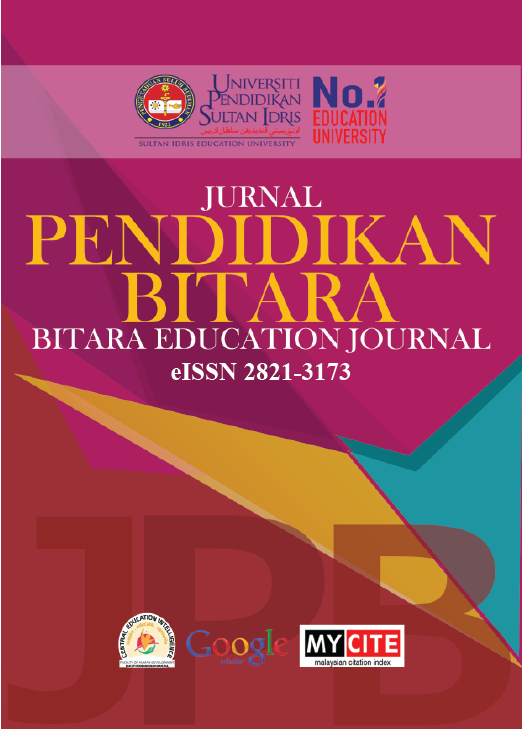Design of Mathematic Learning Module Based on Ethnomathematicsusing Inquiry Method to Improve Mathematical Connection Ability Students of Class VII
DOI:
https://doi.org/10.37134/bitara.vol12.2.2019Keywords:
Modules, Ethnomathematics, Inquiry, Mathematical ConnectionAbstract
Mathematical connections are the ability to link between topics in mathematics, associate mathematics with other sciences, and with daily life. Mathematical connection day is one of the abilities that are the goal of learning mathematics. Teaching materials or modules that are not compatible with mathematical connection capabilities can support learning objectives. Ethnomathematics is one that used in learning mathematics through cultural media that is around students. The inquiry is a way of learning to find solutions in a critical, analytical, and scientific method by using steps to conclusions because facts support them. So, getting ethnomathematics and inquiry combined can improve students’ mathematical connection abilities. This study aims to design teaching materials consisting of ethnomathematics-based mathematical modules using inquiry methods to improve mathematical connections. This research is a type of ADDIE development research. The procedure of this research includes analysis, design, development, implementation, and evaluation. This research is limited to the design stage. The subjects of this study consisted of teachers and students from MTs Al Muhsin II Kasihan in Indonesia. Data collection instruments include observation guidelines, interview guidelines, and documentation sheets. Observation guidelines are used to see the characteristics of students’ mathematical connections. Interview guides are used to determine the teaching material needs of teachers. A documentation sheet is used to obtain data on curriculum implementation in schools. Qualitative-quantitative techniques analyzed data. This research resulted in ethnomathematics are based on module design according to student's needs. This module is designed to improve students’ mathematical connection skills. The results of expert validation on the design of modules get an average value of 4 and are declared valid and can proceed to the next stage.
Downloads
References
Astri, W., Aji, A., Tias, W., & Budiman, S.(2013). Peran Etnomatematika dalam Membangun Karakter Bangsa. In Prosiding Seminar NasionalMatematika. Jurusan Pendidikan Matematika FMIPA UNY.
Barton. (1994). Ethnomathematics: Exploring Cultural Diversity in Mathematics (Ph.D. Thesis, University of Auckland).
Branch, R. M., & Kopcha, T. J. (2014). Instructional design models. In Handbook of research on educational communications and technology (pp. 77-87). Springer New York.
Begg, A & Hamilton. (2001). "Ethnomathematics: Why, and What Else?". ZDM Mathematic Education, 33 (3), 71-74.
Bishop, J.A. (1991).The symbolic Technology Mathematics Calet its Role in Education.Bulletin De La Societe Mathematique, De Belgique, T, XLIII
Bishop, JA (1994). Cultural Conflicts in the Mathematics Education of Indigenous people. Clyton, Viktoria: Monash University.
Bulger, Sean. M., Mohr, Derek. J., Walls, Richard. T. (2002). Stack the Deck in Your Favor of Students by Using the Four Aces of Effective Teaching. Journal of Effective Teaching, 5 (2).
D’Ambrosio, U. (1997). Transdisciplinaridade (Trandisciplinarity). São Paulo, SP, Brazil: Editora Palas Athena.
D'Ambrosio, U. (2006). Preface Prosiding, The International Congress of Mathematics Education CopenhagenPisa: University of Pisa.
Dick, W., & Carey, L. (2001). The systematic design of instruction. London: Longman
Holden, J. T., & Westfall, P. J.-L. (2010). An instructional media selection guide for distance learning - implications for blended learning.NY, USA: United States Distance Learning Association.
Kubieck, J. P. (2005). Inquiry-based learning, the nature of science, and computer technology: New possibilities in science education. Canadian Journal of Learning and Technology / La Revue Canadienne de l’apprentissage et de La Technologie. https://doi.org/10.21432/t29c77
NCTM (National Council of Teachers of Mathematics). (2000). Executive Summary: Principles and Standards for School Mathematics. National Council of Teachers of Mathematics.
NCTM(National Council of Teachers of Mathematics).(2003). Programs for Initial Preparation of Mathematics Teachers. HTTP://www.math.uri.edu/~Eaton/NCATENCTM.pdf (downloaded 20 December 2018).
PISA. (2016). PISA 2015 Results in Focus. In OECD. https://doi.org/10.1787/9789264266490-en
Raja Maisyarah ES. (2017), Mathematical Relation (Connecting Mathematical Ability) Students in Solving Mathematical Problems. Int. J. Sci. Basic Appl. Res., December.
Rusmini, & Edy Sury. (2017). The Effect of Contextual Learning Approach to Mathematical Connection Ability and Student Self- Confidence Grade Viii Smp Negeri 8 Medan. Basic and Applied Research (IJSBAR).
Sproken-Smith, R. (2007). Experiencing the process of knowledge creation: The nature and use of inquiry-based learning in higher education. (online).
(Http://akoaotearoa.ac.nz/sites/default/files/u14/Review.pdf) accessed on July 14, 2018.
Scardamalia, M. (2002). Collective cognitive responsibility for the advancement of knowledge. In B. Smith, Liberal education in a knowledge society (pp. 67-98). Chicago, IL: Open Court.
Trilling, B., & Fadel, C. (2009). 21st Century Skills: Learning for Life in Our Times. San Francisco, CA: John Wiley & Sons.
Wedege, T. (2010). Ethnomathematics and mathematical literacy: People knowingmathematics in society. in In C. Bergsten; E. Jablonka & Tine Wedege (eds.), Published 2010 in In C. Bergsten; E. Jablonka & Tine Wedege (eds.), Mathematics and mathematics education: Cultural and social dimensions. Proceedings of MADIF 7. The Seventh Mathematics Education Research Seminar, Stockholm, 26-27 January 2010 (pp. 31-46). Linköping: Skrifter från SMDF, Nr.7, Linköping Universitet.
Downloads
Published
Issue
Section
License
Copyright (c) 2019 UPSI Press, Malaysia

This work is licensed under a Creative Commons Attribution-NonCommercial-ShareAlike 4.0 International License.





